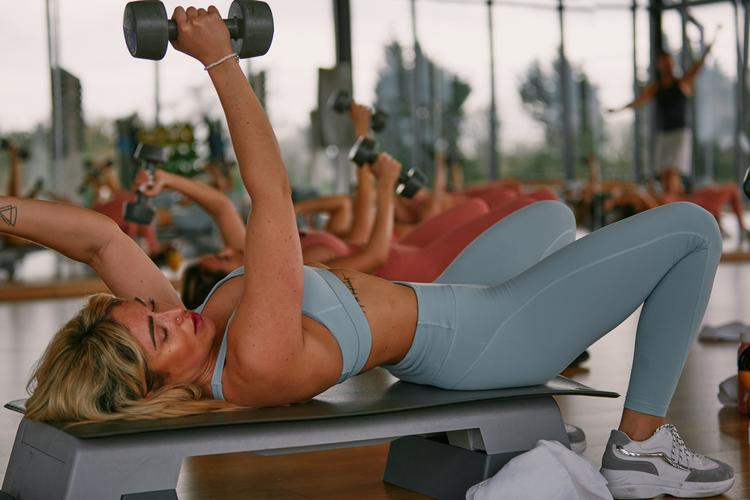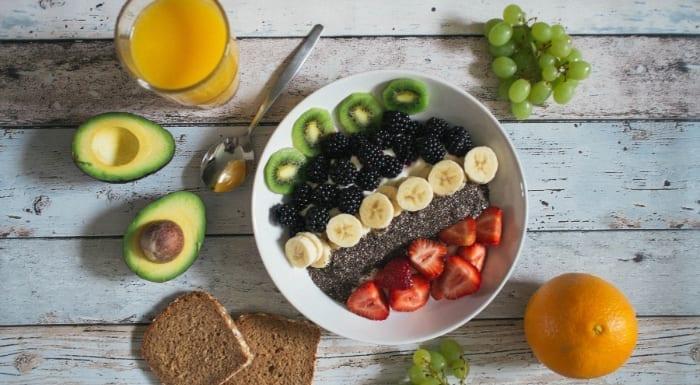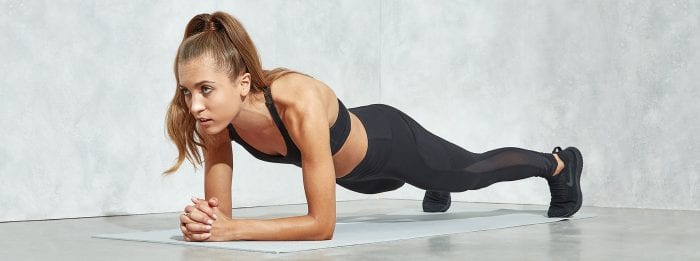How to Lower Body Fat Percentage Through Diet
Burning body fat or losing weight are two of the most common reasons that anyone hits the gym. Although it's not always easy, losing weight and reducing body fat doesn't have to be complicated.
When trying to lose weight, we want to target body fat for reduction while maintaining our muscle mass. Generally, weight loss comes down to simple maths — burning more calories (through exercise) than we're eating.
In this article, you'll find:
-
Fat loss nutrition
-
Exercise for fat loss
-
Anaerobic exercise for fat loss
-
Aerobic exercise for fat loss
-
LISS for fat loss
-
HIIT for fat loss
-
Best ways to reduce belly fat
-
Biggest mistakes when trying to lose body fat
-
What is the recommended body fat percentage?
-
What are the best ways to measure body fat?

Nutrition
When it comes to losing body fat, nutrition is the most important component. It's much easier to sabotage your fat loss by overeating, and it becomes much harder to compensate by working harder at the gym.
Although there are many schools of thought about the best diet for weight loss, they all have one thing in common — calorie reduction.
This can take many different forms. You may want to cut out empty carbohydrates and follow a high-fat keto diet. Or you might reduce your intake of fatty foods and follow a simple low-calorie diet or try intermittent fasting. The key is to find a plan you can follow and stick to it for the long term.
However, fad diets and macro considerations aside, it's essential to choose healthy foods you're fuelling your body with.
You should always consult your physician or a registered dietician for a personalised diet plan. However, following basic guidelines like these can help you to stick to a healthy diet that will lead to fat loss.
You should also consider all three macronutrients — carbohydrates, proteins, and fat.
1. Consume more p rotein
With protein, choose lean options over fatty meats, opt for fish a few meals per week, and focus on plant-based proteins when possible.
When you're cooking, use heart-healthy oils and limit saturated animal fats like butter or lard. Choose dietary fats from fatty fish, avocados, nuts, and seeds instead of deep-fried foods and animal-based fat sources.
Try cutting out added sugar found in sweetened beverages and desserts.
Throughout a weight loss journey when we want to try burn fat specifically, it's essential to take in adequate amounts of protein to protect our muscle mass. Research shows that higher levels of protein during weight loss make it more likely to keep the weight off and help to target fat loss.
Based on your level of exercise, you might need to supplement with extra protein (like Impact Whey Protein ) to help keep your muscle mass while you burn fat.

2. Get enough fibre
Another helpful consideration when losing weight is fibre. Getting adequate soluble fibre from fruits, vegetables, and whole grains will help you feel more satisfied and improve your digestion.
If you don't think you get enough soluble fibre in your diet, you can consider a supplement . Research has shown links between soluble fibre and successful fat loss.
It sounds like a lot to think about, but really following a healthy balanced diet doesn't need to be complicated. When you're trying to lose weight, you want to make sure that you feel satisfied — being hungry all the time isn't essential for burning fat. Choosing satisfying, whole foods and using supplements when you need them can be easy and sustainable to help you meet your fat loss goals.
Exercise
Looking back to the basic fat loss equation, you need to be burning calories — that's where exercise comes in. We all burn a different number of calories even when we aren't exercising (known as our resting metabolic rate) based on our body size and composition.
While it's difficult to measure this number precisely — even in a laboratory setting — some equations can help you estimate how many calories you burn at rest.
If you're interested, check out the Harris-Benedict equation.
3. Do Anaerobic Exercise
Individuals with more lean mass (muscle) burn more calories at rest than those with more fat mass. Think of muscle as active, calorie-burning tissue, while fat is hanging out there for storage purposes without burning as much energy.
This is one of the reasons many people exercise — to optimise the ratio of muscle mass to fat mass, which burns more calories in the long term. We can boost this lean muscle mass through weightlifting, or anaerobic exercise.
One strategy of weightlifting is called "drop sets". This means lifting your heaviest weights for a designated number of sets and reps, and then doing the same exercise with lighter weights until your muscles fatigue. It trains your muscles to work harder and see optimal results. Another strategy is to use "super sets", where you work two opposing muscle groups immediately one after the other without taking a break to recover.
Talk to a personal trainer if you're interested in incorporating either of these strategies into your workouts.
4. Up your cardio (Aerobic Exercise)
The other key part of exercise for losing fat is aerobic activity. "Aerobic" doesn't have to mean the stereotypical '90's step aerobics class with leg warmers and sweatbands (unless you want it to) , but it can be any form of heart-pumping activity, from speed-walking to high-intensity interval training (HIIT).
In fact, both types of cardio, or aerobic exercise, have key benefits and should be incorporated into your weekly routine.
LISS – Low-intensity steady state
LISS cardio is your basic 'jog-in-the-park-style' cardio workout when you're working at a low or moderate pace for a more extended period.
This might be running, cycling, swimming, or using an elliptical machine at the gym. Low-intensity steady state cardio is appropriate for almost all fitness levels. It targets your heart rate in the "fat burning zone" for a longer period of time.
Read up a bit more on LISS with our article below.

Nutrition
The Key Ways To Reduce Body Fat Fast
Start your journey to getting shredded with these essentials.
2020-12-07 16:00:22 • By Claire Muszalski
HIIT – High-intensity interval training
HIIT is a newer approach to cardio that involves shorter, more intense bursts of exercise; think multiple sprints at short distances versus a slower jog for a longer distance.
This type of activity challenges your body and often makes your heartrate elevate quickly, but for a much shorter period than LISS. HIIT training can help you teach your body to recover faster and even lead to increased performance during your LISS workouts.
Learn more about HIIT and fat loss below.

Nutrition
The Key Ways To Reduce Body Fat Fast
Start your journey to getting shredded with these essentials.
2020-12-07 16:00:22 • By Claire Muszalski
Best ways to reduce belly fat
5. Reduce your sugar intake
Belly (visceral) fat is the most dangerous fat to our health. Researchers have found that the most significant dietary culprit when it comes to belly fat is added sugar. Specifically, sugar-sweetened drinks (juices, fancy coffee drinks, soda, etc.) play a large role in the accumulation of belly fat.
When you're choosing your post-workout shakes and protein bars, make sure you aren't overloading on the sugar.
6. Stick to the Basics
Overall, the best ways to lose body fat are to stick to the basics — a healthy diet and a consistent exercise routine.
If you haven't been seeing results, try switching up your exercise routine and incorporating some new strategies to challenge your muscles.

Biggest mistakes when trying to lose body fat
- Don't restrict your food and calorie intake too much — too few calories when working out hard can actually start to break down muscle as well as fat.
- Don't sabotage your workouts by overeating the wrong foods — specifically sugar.
- Remember that losing fat and keeping it off can take some time. Fad diets that promise quick fat loss typically aren't sustainable long term and may be detrimental to your health.
What is the recommended body fat percentage?
Body fat percentage is one way to measure the amount of fat mass vs lean mass and track your progress over time. The following percentage recommendations are based on the American Council on Exercise:
| Description | Women | Men |
| Essential Fat | 10-13% | 2-5% |
| Athletes | 14-20% | 6-13% |
| Fitness | 21-24% | 14-17% |
| Acceptable | 25-31% | 18-24% |
| Obesity | >32% | >25% |
What are the best ways to measure body fat?
There are several ways to measure body fat. The most accurate can require extensive equipment – like underwater weighing and air displacement measurements. These are often reserved for research settings and can be extremely accurate.
For at home measurements, you have several options. You can invest in a tool that helps measure bioelectrical impedance, which is based on how quickly an electrical current (that you won't feel) travels from one side of your body to the other.
Lean mass contains much more water, making it transmit faster – fat mass has less and makes the current move more slowly. You can buy handheld BIA tools or a scale that takes a similar measurement.
Two other , at home options involve taking simple body measurements. You can use body fat callipers , which you use on three different body areas to pinch the skin and enter into an equation to calculate body fat percentage. The other at home option is a simple tape measure – you can track the size of your waist, hips, biceps, and thighs overtime.
Although less accurate, you can easily do these methods yourself.
Take home message
There are lots of strategies out there when it comes to fat loss, but it's best to stick with the basics. A healthy diet with adequate protein, soluble fibre, and limited sugars can help target fat loss, along with a workout routine of weightlifting (to increase and maintain muscle mass) and varied cardio (ideally a combination of LISS and HIIT). Following these tips will not only help you lose fat but also keep your body healthy.
Looking for more nutrition tips from the experts?
Read these next:

Nutrition
10 Supplements To Help Fight Tiredness and Fatigue
Want to feel full of life? These supplements could be the answer.
2019-05-17 10:21:21 • By Claire Muszalski


Our articles should be used for informational and educational purposes only and are not intended to be taken as medical advice. If you're concerned, consult a health professional before taking dietary supplements or introducing any major changes to your diet.
References
1. Lee, J. J., Pedley, A., Hoffmann, U., Massaro, J. M., Levy, D., & Long, M. T. (2018). Visceral and intrahepatic fat are associated with cardiometabolic risk factors above other ectopic fat depots: the Framingham Heart Study.The American journal of medicine,131(6), 684-692.
2. Sacks, F. M., Bray, G. A., Carey, V. J., Smith, S. R., Ryan, D. H., Anton, S. D., … & Leboff, M. S. (2009). Comparison of weight-loss diets with different compositions of fat, protein, and carbohydrates.New England Journal of Medicine,360(9), 859-873.
3. Larsen, T. M., Dalskov, S. M., van Baak, M., Jebb, S. A., Papadaki, A., Pfeiffer, A. F., … & Stender, S. (2010). Diets with high or low protein content and glycemic index for weight-loss maintenance. New England Journal of Medicine, 363(22), 2102-2113.
4. Thompson, S. V., Hannon, B. A., An, R., & Holscher, H. D. (2017). Effects of isolated soluble fiber supplementation on body weight, glycemia, and insulinemia in adults with overweight and obesity: a systematic review and meta-analysis of randomized controlled trials. The American journal of clinical nutrition, 106(6), 1514-1528.
5. Stanhope, K. L., Schwarz, J. M., Keim, N. L., Griffen, S. C., Bremer, A. A., Graham, J. L., … & McGahan, J. P. (2009). Consuming fructose-sweetened, not glucose-sweetened, beverages increases visceral adiposity and lipids and decreases insulin sensitivity in overweight/obese humans.The Journal of clinical investigation,119(5), 1322-1334.
How to Lower Body Fat Percentage Through Diet
Source: https://www.myprotein.co.in/blog/nutrition/ways-to-reduce-body-fat/